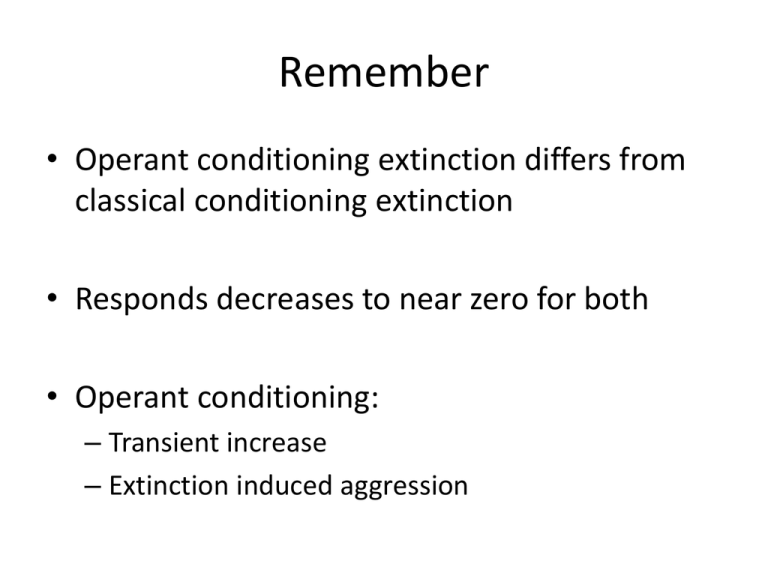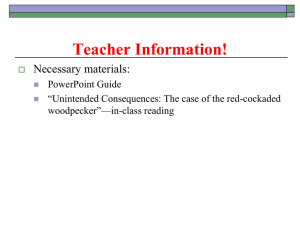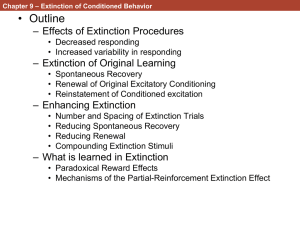Extinction
advertisement

Remember • Operant conditioning extinction differs from classical conditioning extinction • Responds decreases to near zero for both • Operant conditioning: – Transient increase – Extinction induced aggression Partial Reinforcement Extinction Effect: PREE • Extinction occurs at different rates depending on the schedule: – Continuous reinforcement: FAST extinction – Partial reinforcement schedules: SLOWER extinction – Variable schedules show slower extinction than fixed (rate or time) schedules. • PREE used to describe greater persistence in instrumental responding during extinction after partial (or intermittent) reinforcement training – Faster extinction after continuous reinforcement training. • Partial reinforcement schedules show RESISTANCE TO EXTINCTION Other Extinction Effects • magnitude reinforcement extinction effect – Less persistence of instrumental behavior in extinction following training with a large reinforcer – More persistance of responding with a small or moderate reinforcer. – Effect is most prominent with continuous reinforcement. • overtraining extinction effect – Less persistence of instrumental behavior in extinction following extensive training with reinforcement (overtraining) – Faster extinction following moderate levels of reinforcement training. – Again, effect most prominent with continuous reinforcement Other Extinction Effects • reinstatement – Recovery of responding to an extinguished stimulus – produced by exposures to unconditioned stimulus or reinforcer • renewal – Recovery of excitatory responding to an extinguished stimulus – produced by shift away from the contextual cues that were present during extinction. Behavioral Momentum • Suggests that PREE occurs because the animal has a high momentum of responding and it is more difficult to stop this momentum • Timberlake and Lucas 1985: – – – – Ball bearing studies Rolled ball bearing across cage; rats had to let it go past to receive reinforcer Played with the ball bearing, slowing reinforcement During extinction (ball bearing but no food): played with ball bearings MORE • Does suggest that animals show strong patterns of behavior that may interfere and thus slow the extinction process • But not a complete explanation Discrimination and Frustration • Discrimination hypothesis: – Mowrer and Jones 1945 – In order for subjects’ behavior to change during extinction, the subject must be able to discriminate the change in reinforcement contingencies • With CRF: This is immediately noticeable • With PRF: not immediately noticeable – More discriminative on fixed schedules – Less discriminative on variable schedules • Evidence does not completely support this Generalization Decrement Hypothesis • Capaldi, 1966 • Generalization decrement: decreased responding observed in generalization test when test stimuli become less and less similar to training stimulus • Responding during extinction is weak if the stimuli present during extinction are different from those during the reinforcement phase • Responding during extinction is STRONG if the stimuli present during extinction are very similar to those during reinforcement phase. Generalization Decrement Hypothesis • Large generalization decrement when schedule moves from CRF to EXT – Subject never experienced situation in which some of its responses are not reinforced – Not been taught to keep responding in absence of a reinforcer • Small generalization decrement when schedule moves from PRF to EXT – Subject has experience in situation where some of its responses are not reinforced – HAS been taught to keep responding in absence of a reinforcer Sequential Theory • sequential theory: memory of reward vs. non reward – Cognitive theory • Fast extinction after CRF – Extinction occurs quickly because the instrumental response has NOT been conditioned to the memory of nonreward • Slow extinction during PREE – extinction is slowed after partial reinforcement because the instrumental response becomes conditioned to the memory of nonreward. Avoidance: Avoidance Tests • Negative reinforcement = removing a stimulus to INCREASE a behavior • Negative reinforcement = – escape: a response removes something – avoidance: a response prevents some event • Procedure for studying negative reinforcement and avoidance: Discriminated avoidance: – a response CANCELS a shock – Organism is responding for food reinforcers – When light comes on, must press another lever to AVOID the shock • • • if the response does not occur during the S+ the stimulus is followed by a shock if the response does occur during the S+, the shock is cancelled – – thus: signal or sD for shock if this were an escape: response could also occur DURING the shock to shut off shock Two Avoidance Procedures: • Sidman Avoidance: – – – – – the response POSTPONES or DELAYS the shock thus: only temporary solution must keep responding to keep delaying the shock results in lots of responding again: some signal may be used to signal when must respond • Herrnstein and Hineline Procedure: – – – – the response reduces the rate of the shock note: note delay or cancel, just slows down rate of delivery the response switches the schedule of shock to a lower rate Note: cannot entirely AVOID shock in this procedure: • once animal receives shock on lowered schedule, reverts back to original schedule • animal must respond again to switch schedule again Characteristics of Avoidance Behavior • extremely variable: – from subject to subject – from session to session with SAME subject – procedure to procedure • choice of response is important – determines how quickly will learn contingency – how well learning is maintained • 1-way vs 2-way shuttle avoidance tests: – 1-way shuttle: run to other end w/sD – 2-way shuttle: run to opposite end w/sD – rat will learn to run to other end of shuttle box when sD comes on to avoid shock • difficult time learning 2-way shuttle avoidance Characteristics of Avoidance Behavior • Species specific Defense reactions: – behaviors which animal does naturally in time of danger – includes: freezing, fleeing, fighting • Why? – animal has innate behaviors does when avoiding noxious stimulus– can't make it go against its nature Characteristics of Avoidance Behavior • Negatively reinforced behavior is difficult to extinguish: – escape behaviors take long time to go away – e.g.: rat in 1-way shuttle still runs when light comes on-even after hundreds of EXT trials • BUT: will extinguish quickly if animal can detect change from conditioning to EXT situation Negative Reinforcement in Humans • most often "reinforcement" technique used in real world • often used because is cheaper, easier, more natural • produces "bad" side effects: avoidance responses to sD = boss, principal, spouse, etc. Theories of Avoidance: Two Factor theory • Two things happen during avoidance conditioning: – animal learns to fear S+ via class. cond'ing • • CS (light)---> US (shock): UR (fear) animal learns to fear light via pairing with shock – animal will then learn a response to AVOID shock and thus remove/lessen their fear • thus: not getting shocked reduces fear that was signaled by the CS • experimental evidence: – on initial training trials: – light/CS produces physiological symptoms of fear – escape response results in decrease in these physiological symptoms • on later trials: – little or no evidence of physiological fear with CS presentation – suggests fear has been reduced/replaced by the escape response • in sense: forms a negative feedback loop Two Factor theory in Humans • many ineffective and/or irrational fears – often involve avoidance responses due to original fear – maintained by decrease in fear – e.g., banging two sticks to keep the tigers away • Symptoms of obsessive/compulsive disorders: – compulsions = repeated, stereotyped, ritualized actions • individual feels compelled to engage in them – obsessions = compulsive thoughts (no actual actions) – many, many examples of this – can begin to interfere in life Problems with 2-factor theory: • Signs of fear dissipate w/time: – as animal gets "better" at avoidance response – thus: no fear to be avoided • the CS is not as important in avoidance learning as 2-factor theory states: • animals can learn to avoid in a discriminated avoidance situation long before there is any sign that they are responding to/detecting the CS Herrnstein and Hineline: Test of 2-factor theory • Herrnstein and Hineline procedure: – not use any CS, but the animal still learns to lessen/avoid the shock • Test of the theory: – two groups of rats used – Group 1: can turn off light, but still shock – Group 2: can turn off shock, light still on • 2-factor theory would predict that Group 1 should respond more, because this would be cancelling the CS that produces fear • results: group 2 responds much more accurately, faster Alternative: One-Factor Theory • responses occur whenever they reduce the rate at which aversive events occur • when a CS is present: only providing information about the effectiveness of a response • fear may be a by-product of avoidance training, but not crucial to learning/ maintaining an avoidance response Evidence for One-Factor theory • Almost postulating a "cognitive" theory of avoidance: • Seligman and Jonston (1973) did postulate cognitive theory: – like Rescorla Wagner theory in that deals with predictability • Basic premise: – learning occurs only when discrepancy between observation and expectation – subjects' behavior will change in avoidance task whenever there is a discrepancy between expectancy and observation Evidence for One-Factor theory • Two important expectations in avoidance task: – expectation about consequences of a response – .expectation about consequences of not responding • Data support One-factor theory – on trial 1: no expectations – On trial 2 (and more): expectation about what will happen • no shock will occur if response is made – shock will occur if no response is made – animal prefers no shock to shock- so responds • Contingency is what is important in avoidance, fear is by-product! Flooding as an aversive: • To extinguish an inappropriate response: must make contact with "changed reinforcement or punishment" situation • sometimes used as alternative to systematic desensitization • flood with presentation of fear-provoking stimulus – Again, no actual consequence occurs – Continue presentations until the response is extinguished • Problem: may "scare the patient to death" Punishment can lead to Aggression • Reflexive aggression: – When punished, act out aggressively – Is called reflexive because appears to be innate – When in pain, you bite! • Operant Aggression – Learn to be aggressive contingently – retaliatory Punishment can lead to Aggression • Aggression may model aggression – That is, aggression breeds aggression – Use of aggression as punishment may provide model of how to “solve problems” • Social Disruption – The person who delivers the punishment/situation in which punishment occurs become tainted – Poisoning cues – Also called social disruption: • Behavior is disrupted in presence of cues that predict punishment • May get freezing, reduced effort, etc., in presence of punisher Evidence, con’t. • as long as animal continues to respond- no shock – not know when extinction occurs- no sampling – only stop when learn situation has changed • Thus: to EXT responding: – – – – Must use response blocking or flooding: present sD, but prevent R from occurring thus animal learns that shock no longer comes animal stops responding in presence of sD Learned helplessness Marty Seligman • Four groups of dogs Grp Grp Grp Grp Training I and II I Escapable/escapeable II Inescapable/inescapable III Escapable/inescapable III Inescapable/escapable result Lasting effects run None not run None not run None not run Severe Remember, Seligman’s hypothesis was that NONE of the dogs would be significantly harmed. Key Factor = inescapability once learned not to escape (learned to be helpless)= not change Characteristics of L.H. • inescapability that produces phenomenon, not the shock itself • works under variety of procedures, conditions • very generalizeable, transferable • if take far enough, can make it a contingency rule for the animal, rather than specific contingency for specific situation(s) Symptoms of L.H. • • • • • passivity learned laziness retardation of learning somatic effects reduction of helplessness with time Clinical expressions of learned helplessness • School phobias and math anxiety • Abusive Relationships • Depression • Cultural learned helplessness “Curing” or eliminating learned helplessness • Unlearn the rule • Reshape or recondition • Must be done in situation where organism cannot fail • Difficult to do- animals can “not” respond • UPenn program on relearning thoughts during test taking Why? • Only when shock contingent on behavior do animals develop LH – Animals in no control/no control condition do not develop • Showed generalization very quickly – In situations where there WAS a contingency, the lack of behavior sabotaged results How is this an example of the importance of contingency? • Got themselves into contingency trap • If they don’t work, no reward, only punishment • This reinforced contingency rule that THEY were the cause of the bad consequences • Self sabotage • And it was true! • Thus: treatment must be to learn better contingencies and eliminate the bad (and in their head) contingency rule Why is this important for humans? • Helps explain the “misbehavior” of humans with some disorders • Drug addicts and those with schizophrenia make “poor” choices – May be due to physiology of the addiction or disease – “bad choices” may be due to effect of DA – Real changes may be occurring in the brain which prevent the addict from being sensitive to changes in his or her life rewards • May also explain some of the perseverative and off-task behaviors observed in these individuals What “causes” LH? • Newer research: original theory of learned helplessness NOT account for people's varying reactions to situations that can cause learned helplessness • Learned helplessness sometimes remains specific to one situation • At other times generalizes across situations • At first, difficult to predict which will occur in a given situation Attributional Style • attributional style/explanatory style: – key to understanding why people respond differently to adverse events – Refers to how individuals attribute cause to an outcome • group of people all experience same or similar negative event – BUT: each person person privately interprets cause of event – HOW one attributes causes to event will appears determine likelihood of LH Pessimistic explanatory style • sees negative events as – permanent : "it will never change“ – Personal: “it's all my fault“ – pervasive: "I can't do anything correctly“ • These individuals most likely to suffer from learned helplessness and depression Optimistic explanatory style • sees negative events as – Out of the ordinary: “tomorrow is a new day! “ – Impersonal: “it's NOT really my fault“ – Temporary: "I can do most things correctly“ • These individuals least likely to suffer from learned helplessness and depression Cognitive Behavior Therapy • Endorsed by Seligman, • Teaches people more realistic explanatory styles, • Shown to help ease depression. • Steven C. Hayes (U of Utah): recommends acceptance and commitment therapy to get rid of negative thoughts. Attribution Theory • Bernard Weiner (1979, 1985, 1986) • Examines how people attribute a cause or explanation to an unpleasant event. • Includes the dimensions of – globality/specificity: – stability/instability – internality/externality Global vs. specific Attributions • Specific attribution: individual believes cause of a negative event is unique to a particular situation. • Global Attribution: individual believes the cause of a negative event occurs across situations Stable vs. Unstable • Stable attribution: individual believes the cause to be consistent across time. • Unstable attribution: individual thinks that the cause is specific to one point in time. External vs. Internal • External attribution: assigns causality to situational or external factors • Internal attribution: assigns causality to factors within the person How develop positive thinking styles? • Innoculation programs • Teach to deal with failure! – Must experience failure to learn to frame it appropriately • Who is more likely to get depressed? • Straight A valedictorian receiving first C • B average student receiving first C • Why? • You aren’t learning if you don’t make “mistakes” – Mistakes are exploring the boundaries of a contingency! Conclusions • We are animals and we behave in ways that are consistent with other species. • There are biological boundaries or constraints in how we learn and react to our environment • Our biggest Human instinct: to learn, predict and control our environment • HOW we attribute causes influences the development of rules or heuristics for causation • Animal models allow us to investigate these boundaries and help explain human learning and choice behavior!




![Electrical Safety[]](http://s2.studylib.net/store/data/005402709_1-78da758a33a77d446a45dc5dd76faacd-300x300.png)

